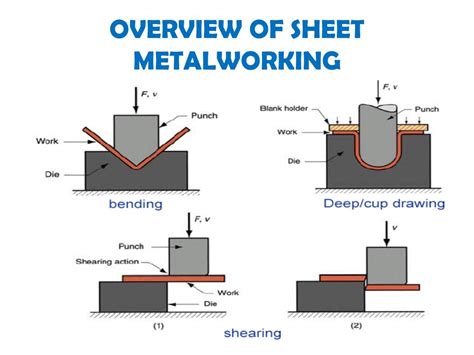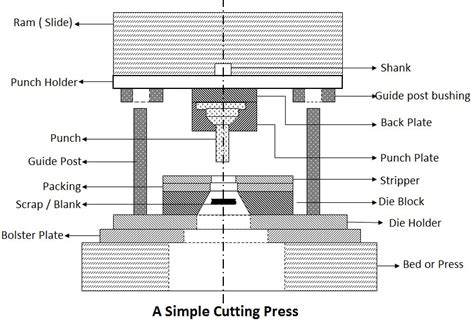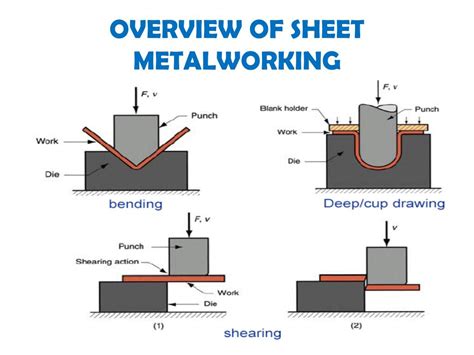three major sheet metal forming processes The process of producing sheet metal components using metal sheets is known as sheet metal forming or sheet metal fabrication. This is accomplished by bending, punching, shearing, hydroforming, and other .
Externally vented range hood offers powerful performance; Rocker switch for simple fan speed adjustment; 190 CFM blower quickly removes smoke and cooking odors from the air; Removable, dishwasher-safe metal mesh grease filter for easy cleaning and maintenance
0 · sheet metal working process pdf
1 · sheet metal stamping process pdf
2 · sheet metal processes pdf
3 · sheet metal forming process pdf
4 · sheet metal forming press dies
5 · sheet metal forming by hand
6 · sheet metal bending process pdf
7 · bulk deformation vs sheet metal forming
$99.00
forming operations: The three major categories of sheet-metal processes are (1) cutting, (2) bending, and (3) drawing as shown in figure (9.2). Cutting is used to separate large sheets into smaller pieces, to cut out part perimeters, and to makemetal forming operations: The three major categories of sheet-metal processes are (1) cutting, (2) bending, and (3) drawing as shown in figure (9.2). Cutting is used to separate .
Sheet metal forming processes 9.4 Types of metal forming operations: The three major categories of sheet-metal processes are (1) cutting, (2) bending, and (3) drawing as shown in figure (9.2). . Also known as sheet metal fabrication, sheet metal forming uses metal sheets to make various products and components. The metal sheets are formed and cut into the necessary shape and size via many different .
After cutting, sheet metal components often undergo forming processes, such as bending and stamping, to shape them into three-dimensional configurations. Bending involves applying force to the sheet along specific lines, creating . The process of producing sheet metal components using metal sheets is known as sheet metal forming or sheet metal fabrication. This is accomplished by bending, punching, shearing, hydroforming, and other .
Sheet metal forming processes are typically performed at room temperature on machined tools called Presses using Dies. The parts are referred to as “Stampings”. Sheet metalworking processes. Sheet metalworking . Table of Contents hide. 1 What is Sheet Metal Forming? 2 Working Mechanism of Sheet Metal Forming. 3 Difference between Hot & Cold Metal Forming. 4 Common Techniques For Sheet Metal Forming Processes. 4.1 .
In this comprehensive guide, we will explore different types of sheet metal forming processes, materials used, design considerations, tooling and equipment, process steps, quality control, troubleshooting, .
Techniques and Processes. Sheet metal forming involves several key techniques and processes, each tailored to specific applications and desired outcomes. These include: 1. Bending. Bending is a fundamental sheet metal .Chapter 7 Sheet-Metal Forming Processes Questions 1. Section 3.3.4) have a major influence on formability (Section 7.7 on p. 397). Select any three topics from Chapter 2, and, with specific examples for each, show their relevance to .proved by the numerical simulation of various sheet metal forming processes: bulge and stretch forming, deep-drawing and forming of the complex parts. A section has been devoted to the robust design of sheet metal forming processes. Springback is the major quality concern in the stamping field. Consequently, two sections of thisThe three major categories of sheet-metal processes are (1) cutting, (2) bending, and (3) drawing as shown in figure (9.2). Cutting is used to separate large sheets into smaller pieces, to cut out part perimeters, and to make holes in parts.
This paper aims at scattering light on the recent research and developments in the sheet metal forming processes over the last two decades. Most of the literature available on sheet metal forming focuses on the parameters that influence the .

china lianjiatai non standard sheet metal equipment processing
sheet metal working process pdf

Metalworking is one of the three major technologies used to fabricate metal products. This article tabulates the classification of metal forming processes. It discusses different types of metalworking equipment, including rolling mills, ring-rolling machines, and thread-rolling and surface-rolling machines.Forming of shallow parts using rubber tools. Maziar Ramezani, Zaidi M. Ripin, in Rubber-Pad Forming Processes, 2012. 4.1 Introduction. Sheet metal forming is a costly manufacturing process that is widely used in different industries. Many small companies are required to manufacture curved products and shallow parts with fine details in a small lot size which leads to both a .
The forming analysis system ARGUS supports the optimization of the sheet metal forming process. For the automatic optical forming analysis, sheet metal blanks are marked with a regular dot pattern with 1 mm, 2 mm or 3 mm distance in between the dots, depending on the shape and radians of the part. The three major sheet metal forming processes are: Bending:. Description: In bending, a force is applied to a piece of sheet metal to bend it to an angle and form the desired shape.This is commonly done using a press brake, which has a punch and die. Applications: Used to create parts with simple or complex bends, such as brackets, enclosures, and frames. This sheet metal forming process is often used for vehicle body parts, enclosures, and electrical components. It can be performed on most compatible sheet metal forming materials, like stainless steel, brass, aluminum, and galvanized steel. It does have some limitations, however; the metal needs to have the same thickness throughout, and .
However, there are two categories of sheet metal operations: cutting and forming. Under the two subcategories, there are nine other processes that make up sheet metal operations as a whole. 1. Shearing. . It is a sheet metal process done to the edge of the sheet, whether creating a 90-degree angle and a T-shaped corner in the sheet or making .
Describe the three major sheet metal forming processes. Your solution’s ready to go! Our expert help has broken down your problem into an easy-to-learn solution you can count on.Sheet Metal Forming Processes Dorel Banabic Sheet Metal Forming Processes Constitutive Modelling and Numerical Simulation 123 Prof. Dr. Ing. Dorel Banabic Technical University of Cluj-Napoca Research Centre on Sheet Metal Forming – CERTETA 27 Memorandumului 400114 Cluj Napoca Romania [email protected] ISBN 978-3-540-88112-4 e-ISBN 978-3-540-88113-1 .Why is lubrication often a major concern in metal forming? It reduces friction, acts as a coolant, thermal barriers, corrosion inhibitors, and parting compounds. . Metal forming processes are complex systems composed of many variations of processes amassing to quite a large amount.
92 8 Sheet Metal Forming Processes Fig. 8.10 Mechanics of fracture Table 8.2 Recommended clearances between die and punch Material Clearance per side percentage of stock thickness Average (%) Range Aluminium alloys Cold rolled steels (soft) Cold rolled steels (half-hard) 2.25 3.0 .Sheet Metal Forming Processes - Free download as PDF File (.pdf), Text File (.txt) or read online for free. Sheet metal forming processes are used to produce a wide range of consumer and industrial products from sheet metal. The three .
cutting and forming operations performed on relatively thin sheets of metal. Presses. where most sheet metal operations are preformed . sheet metal products. Three major categories of sheet metal processes. cutting, bending, drawing. Plastile deformation. as punch beings to push into the work. Penetration. punch compresses the sheet and cuts .
is a metal forming process in which a force is applied to a piece of sheet metal, causing it to bend at an angle and form the desired shape. . is a metal forming process in which sheet metal is progressively shaped through a series of bending operations. About us. About Quizlet; How Quizlet works; Careers; Advertise with us; Get the app; Sheet metal forming processes are typically performed at room temperature on machined tools called Presses using Dies. The parts are referred to as “Stampings”. Sheet metalworking processes. Sheet metalworking processes are classified into three categories: bending, sheet metal drawing, and shearing. Shearing – Cutting. Shearing; Blanking .
sheet metal stamping process pdf
Metal forming refers to various processes you can use to shape or manipulate materials. Depending on the type of formed part you want, it is vital to adopt a suitable technique. In this article, we will cover 19 different operations you can use to fabricate your metal parts. Let’s dive right in: 1. Rolling Metal [.]The three major categories of sheet metal processes are: A: is used to separate large sheets into smaller pieces, to cut out part. perimeters (blanking), and to make holes in parts (punching or piercing). B. Bending: straining sheet around a straight axis C. Drawing : forming of sheet into convex or concave shapes The paper defines this new class of sheet-bulk metal forming processes, gives an overview of the existing processes belonging to this class, highlights the tooling aspects as well as the resulting product properties and presents a short summary of the relevant work that has been done towards modeling and simulation. . Three major .
This practical and comprehensive reference gives the latest developments on the design of sheet forming operations, equipment, tooling, and process modeling. Individual chapters cover all major sheet forming processes such as blanking, bending, deep drawing, and more.Chapter 7 Sheet-Metal Forming Processes Questions 7.1 Select any three topics from Chapter 2, and, with specific examples for each, show their relevance to the topics described in this chapter. Section 3.3.4) have a major influence on formability (Section 7.7 on p. 397). This is an open-ended problem, and students can develop a wide range of .May 7, 2024 — cover all major sheet forming processes such as blanking, bending, deep drawing, and more. Process modeling using finite element analysis is described in one chapter and discussed in all . sheet-metal-forming-processes-constitutive-modelling-and-numerical-simulation-1-ed-10 2 Downloaded from resources.caih.jhu.edu on 2022 . When the forming process the sheet metal and tooling are heated together and then high pressure of gas is applied. That case, the sheet metals are plastically deformed into desire shape of die cavity. . The major sheet metal processes for micro forming are shearing, blanking, bending, stamping, deep drawing, hydro forming, stretch forming .
Although the advantages of formability are notable, blow-forming processes, which are classified as sheet metal stretching processes, present limits in terms of uniformity of the thicknesses of the produced product. Metal Forming Processes. satyendra; May 5, 2016; . Metalworking technology is one of three major technologies used for the fabrication of the metal products. The other two are casting process and powder metallurgy (P/M) technology. . presses are the most widely used and are applied to both bulk forming and sheet forming processes. Presses .
china metal aluminium joint box

Underground electrical enclosures and covers protect electrical and data cables and wiring from weather-related damage. Underground electrical enclosures couple with enclosure covers (sold separately) to shield electrical cables and devices from water, frost, and rust.
three major sheet metal forming processes|sheet metal bending process pdf